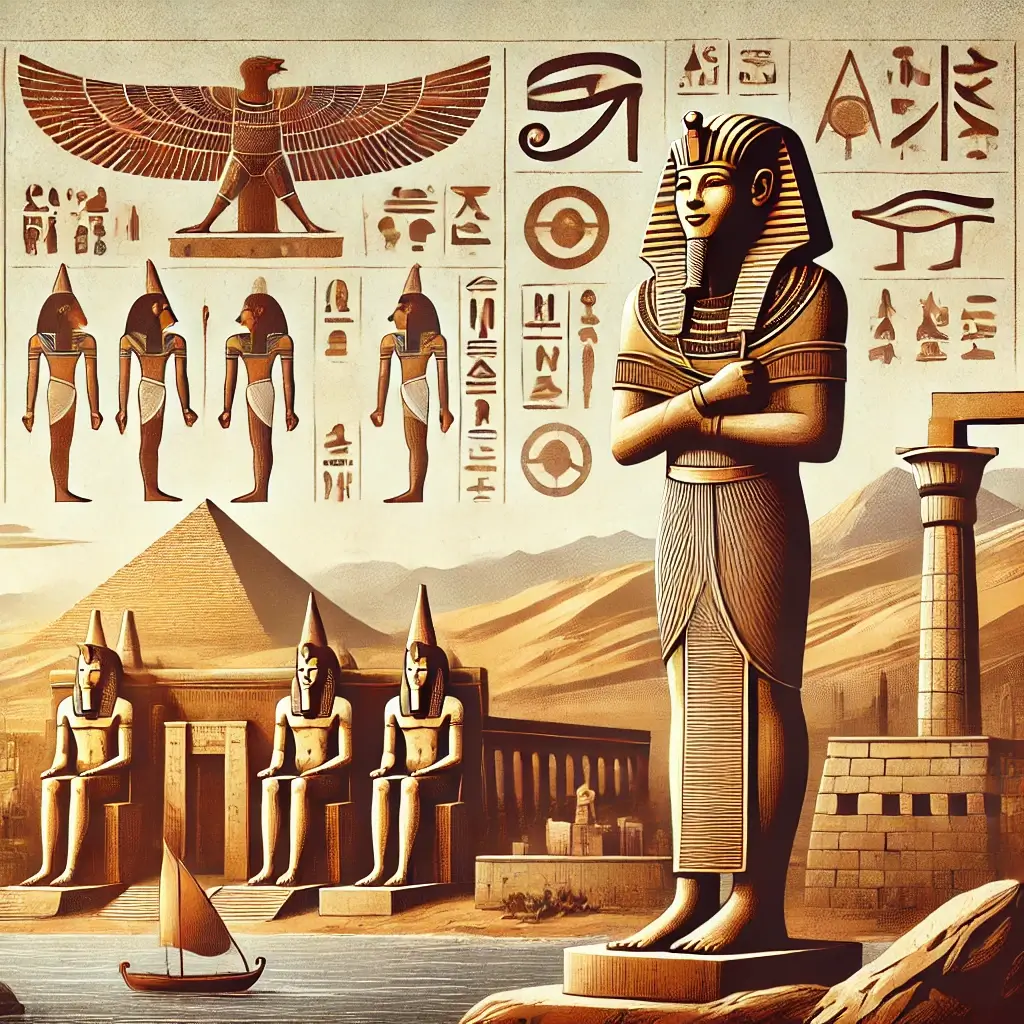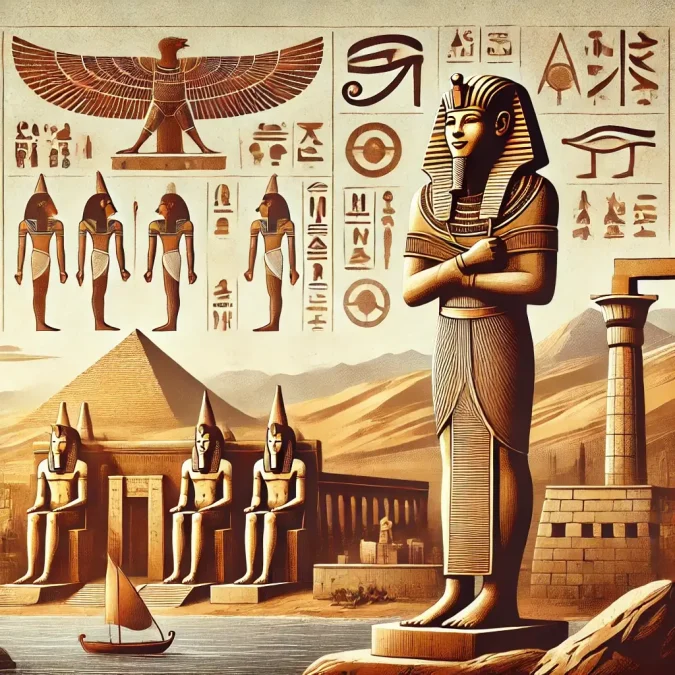
The Second Dynasty of ancient Egypt (c. 2890 – c. 2686 BC) represents the latter phase of the Archaic Period, which marked the early stages of ancient Egyptian civilization. Following the successful unification of Upper and Lower Egypt during the First Dynasty, the Second Dynasty continued to develop the political, cultural, and religious foundations of the Egyptian state. During this time, the seat of government remained centered at Thinis, a city in Upper Egypt that played a pivotal role in the early history of the unified kingdom.
The Second Dynasty was a period of both continuity and challenge, as Egypt transitioned from the initial consolidation of power under the First Dynasty to a more mature state structure. The rulers of the Second Dynasty faced various internal and external pressures, including challenges to central authority and the need to maintain the unity of the kingdom. Despite these challenges, the Second Dynasty contributed significantly to the development of the Egyptian state and laid the groundwork for the Old Kingdom, a period of remarkable cultural and architectural achievement.
In this article, we will explore the history, rulers, culture, and achievements of the Second Dynasty, examining how the early kings navigated the complexities of governing a unified Egypt. We will also discuss the major accomplishments and cultural advancements of this period, which set the stage for the flourishing of ancient Egyptian civilization in the centuries that followed.
The Historical Context of the Second Dynasty
The Archaic Period: Foundation of the Egyptian State
The Archaic Period, also known as the Early Dynastic Period, encompasses the First and Second Dynasties of ancient Egypt. This era, which lasted from approximately 3100 BC to 2686 BC, was a formative period during which the political, social, and cultural structures of the Egyptian state were established. The unification of Upper and Lower Egypt by King Narmer, traditionally considered the first pharaoh of the First Dynasty, marked the beginning of this period.
The Second Dynasty built upon the achievements of its predecessors, continuing to develop the centralized administration, religious institutions, and social hierarchy that would characterize ancient Egyptian civilization. The kings of the Second Dynasty were responsible for maintaining the unity of the kingdom, expanding its territory, and overseeing the construction of religious and administrative structures. Despite the challenges they faced, the rulers of the Second Dynasty played a crucial role in shaping the early Egyptian state and ensuring its continuity.
The Rulers of the Second Dynasty
The Second Dynasty of Egypt consisted of several kings whose reigns are known primarily from archaeological evidence and historical records. Although there is some debate among historians regarding the exact sequence and length of their reigns, the following is a summary of the key rulers of the Second Dynasty and their contributions to Egyptian history.
King Hotepsekhemwy
Hotepsekhemwy was the founder of the Second Dynasty and succeeded Qa’a, the last ruler of the First Dynasty. His name, which means “The Two Powers Are at Peace,” suggests that his reign was marked by efforts to reconcile competing factions within the kingdom, possibly indicating a period of internal conflict at the end of the First Dynasty. Hotepsekhemwy’s reign is believed to have been relatively stable, and he worked to maintain the unity of Upper and Lower Egypt. He is also credited with continuing the construction of religious and administrative structures, contributing to the consolidation of the early Egyptian state.
King Raneb (or Nebra)
Raneb, also known as Nebra, was the second ruler of the Second Dynasty. His name, which means “Lord of the Sun,” reflects the growing importance of the sun god Ra in Egyptian religion. Raneb is believed to have expanded the influence of the sun cult, which would later become a central aspect of Egyptian religious life. During his reign, Raneb continued the policies of his predecessor, focusing on maintaining the unity of the kingdom and overseeing the construction of religious monuments. His reign is considered a period of relative stability, with no significant evidence of major conflicts or upheavals.
King Nynetjer
Nynetjer was the third ruler of the Second Dynasty and is thought to have had a long and prosperous reign. His name, which means “He Who Belongs to the God Nynetjer,” indicates a strong connection to the divine, reflecting the pharaoh’s role as both a political and religious leader. Nynetjer’s reign was marked by significant administrative developments, including the establishment of new governmental offices and the division of administrative responsibilities.
During Nynetjer’s reign, there is evidence of increased religious activity, including the construction of temples and the promotion of state-sponsored religious ceremonies. However, his reign also saw the beginnings of internal divisions, which may have been related to disputes over succession or regional power struggles. These divisions would become more pronounced during the later part of the Second Dynasty.
King Sekhemib (or Peribsen)
Sekhemib, also known as Peribsen, is a somewhat enigmatic figure in the history of the Second Dynasty. Unlike his predecessors, who associated themselves with the god Horus, Sekhemib chose to associate his name with the god Seth, a deity often associated with chaos and disorder. This unusual choice has led to speculation that Sekhemib’s reign was marked by internal conflict, possibly involving rival factions within the royal family or the priesthood.
The decision to adopt the Seth name may indicate an attempt to break with the traditions of his predecessors or to assert his authority over a divided kingdom. Sekhemib’s reign is notable for the construction of significant religious monuments, including a tomb at Abydos that reflects the continued importance of the necropolis as a center of royal burial.
King Khasekhemwy
Khasekhemwy was the last ruler of the Second Dynasty and is considered one of the most significant kings of this period. His name, which means “The Two Powers Appear,” suggests a reunification of the kingdom after a period of internal strife. Khasekhemwy is believed to have successfully reunited Upper and Lower Egypt, bringing an end to the divisions that had plagued the later part of the Second Dynasty.
Khasekhemwy’s reign was marked by significant architectural achievements, including the construction of large stone structures at Hierakonpolis and Abydos. His tomb at Abydos is one of the largest and most elaborate of the Early Dynastic Period, reflecting the wealth and power of the pharaoh. Khasekhemwy is also credited with initiating the use of stone as a building material, a practice that would become a defining feature of Egyptian architecture in later periods.
Cultural and Religious Developments of the Second Dynasty
The Evolution of Kingship and Religious Practices
The Second Dynasty of Egypt saw the continued evolution of the concept of kingship, with the pharaoh being viewed as both a political and religious leader. The early pharaohs of the Second Dynasty were closely associated with the god Horus, who was considered the protector of the king and the embodiment of royal power. However, the reign of Sekhemib (Peribsen), who chose to associate himself with the god Seth, suggests that there were competing religious ideologies during this period.
The association with Seth may have been an attempt to legitimize a claim to the throne or to assert authority over rival factions. Despite these challenges, the pharaohs of the Second Dynasty continued to promote the concept of divine kingship, which would remain a central feature of Egyptian political and religious life for millennia. The construction of temples and the promotion of state-sponsored religious ceremonies helped to reinforce the pharaoh’s role as the intermediary between the gods and the people.
Burial Practices and Royal Tombs
Burial practices during the Second Dynasty continued to reflect the importance of the afterlife in ancient Egyptian religion. The pharaohs of the Second Dynasty were buried in large tombs at Abydos, which served as the royal necropolis. These tombs were constructed with mudbrick and included multiple chambers for the burial of the king, as well as storage rooms for grave goods, which were intended to provide for the pharaoh in the afterlife.
The tomb of Khasekhemwy at Abydos is particularly notable for its size and complexity, as well as the use of stone in its construction. This represents an important development in Egyptian architecture, as the use of stone would become a defining feature of the monumental structures of the Old Kingdom. The royal tombs of the Second Dynasty also contained inscriptions and early forms of writing, which provide valuable insight into the religious beliefs and practices of the period.
Art, Architecture, and Technological Innovations
The Second Dynasty saw the continued development of early forms of art and architecture that would become defining features of ancient Egyptian civilization. The construction of monumental tombs and funerary enclosures at Abydos and Saqqara demonstrates the growing importance of architecture as a means of expressing royal power and authority. These early structures, built from mudbrick and, in some cases, stone, served as precursors to the stone pyramids and temples of later periods.
Artistic developments during the Second Dynasty included the production of finely crafted pottery, jewelry, and ceremonial objects. The use of hieroglyphs became more standardized during this period, contributing to the development of a written language that was used for administrative, religious, and ceremonial purposes. The introduction of stone vessels, copper tools, and other technological innovations during this period reflects the growing complexity of Egyptian society and its increasing ability to harness natural resources for the benefit of the state.
Conclusion
The Second Dynasty of ancient Egypt was a period of both continuity and challenge, as the early pharaohs worked to maintain the unity of the kingdom and develop the political, cultural, and religious institutions that would define Egyptian civilization. Despite internal divisions and challenges to central authority, the rulers of the Second Dynasty played a crucial role in shaping the early Egyptian state and laying the groundwork for the Old Kingdom, a period of remarkable cultural and architectural achievement.
The legacy of the Second Dynasty is evident in the continued development of the concept of divine kingship, the construction of monumental architecture, and the establishment of religious and administrative institutions that would endure for millennia. The achievements of these early kings, from Hotepsekhemwy to Khasekhemwy, reflect the ingenuity and ambition of the ancient Egyptians as they sought to create a unified and prosperous kingdom along the banks of the Nile.
